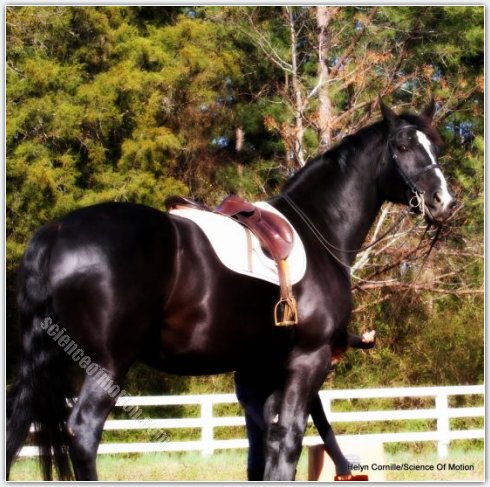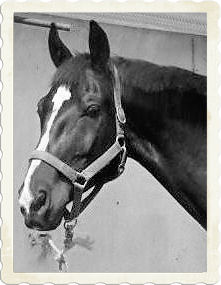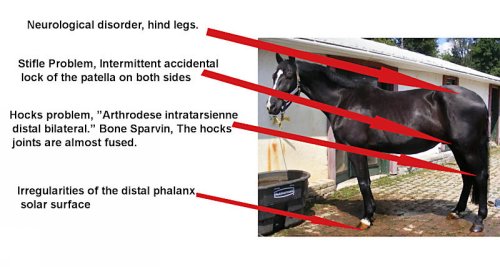Manchester Last Chance
A New Case Study
Update on Manhester Photo 2013

“Manchester’s last chance”

Two hundred thousand years ago, a Homo Sapiens had the intellectual curiosity to walk on the other side of the hill to see how the world looks like. It was the emergence of the human intelligence.
Manchester’s Last Chance
Jean Luc Cornille
"The only way of discovering the limits of the possible is to venture a little way past them into the impossible." (Arthur C. Clarke) In Manchester's case, the limits of the possible are not good enough. We invite you into the "impossible", a blend of classical aspiration and modern science that may restore Manchester's soundness.
Manchester's re-education is a unique experience. The horse is not a case of abuse, neglect, or poor training that could be fixed by improving on methods previously used. Rather, Manchester case is one of these idiopathic lameness that are beyond the scope of conventional and alternative therapies.
Helping us you will enter a world that will further your own experience, riding skill and training philosophy. The science of motion can achieve recoveries beyond the scope of conventional thinking because the science of motion focuses on the source of all body's movement, the horse's vertebral column and reeducate the vertebral column through the horse's movements.
Manchester was bred, born, and raised at a very successful breeding farm, which is owned by Ludwin and Alain Verdier. Blauenstein Farm has produced many international level horses. Manchester's Sire is the stallion Macho which was imported to Canada in 1998, and successfully ridden by Ashley Holtzer. Manchester's half -brother is the famous Canadian breeding stallion Royal Senna.
Manchester has won Alain's heart. He was his favorite horse and the decision to donate him to the Science of Motion is motivated by the pure desire to give him a chance to succeed, where all else has failed.
If the problem were simple, it would already have been fixed. Breeding farms of this caliber are optimally equipped and work with superior veterinarians and other aids. If Manchester's re-education proves to be a success, it is because we do not hesitate to explore pertinent applications of advanced scientific discoveries.
By helping us to help Manchester, you are placing yourself on the cutting edge. Whether or not we fully or partially succeed, you will gain the knowledge of the scientific studies supporting our working hypothesis. You will discover how the practical application of advanced scientific knowledge fundamentally transforms riding and training principles.
Conventional approaches to riding and training do not act on the biomechanical properties of the horse's vertebral column that are influencing the kinematics of the hind and front legs, and so, have failed to rehabilitate. Driving the horse onto a low, deep and round neck are precisely the principles of riding and training that have lead the horse into his physical predicament.
Helping us to help Manchester, you will observe how the rider lets the horse think and guides the horse's mental processing toward an awareness in order to gradually master the biomechanical properties of his vertebral column.
Manchester's Last Chance

MEDICAL EXAM
Manchester was presented at the Montreal University of Veterinary Medicine for complete assessment of his condition.
The exam diagnosed;
Stifle Problem. The stifle joint is stabilized between two main muscles on the outside and ligaments on the inside. Often this type of stifle problem results from imbalance between the tension created by the muscles and the ligaments. The two muscles are the quadriceps femora and a branch of the biceps femora. Proper tension can be recreated through gymnastic exercises developing the strength and tone of the Quadriceps and Biceps.
Other times the problem results from excessive rotation of the hind limb around the hip joint. The problem can be resolved increasing the dorso-ventral rotation of the pelvis. Frequently, stifle situations result from a combination of both issues. This will be a great opportunity to show how these gymnastics can be done.
Hocks problem. As the joints are fused, the reeducation will have to focus on the abnormal stresses that created the collapse between the joints. Finding the source will ease excessive strains on the hock joints. This will be a great opportunity to show and explain how hocks problems can be prevented
Irregularity of the solar surface of the distal phalanx
(Coffin Bone). The solar surface of the coffin bone is situated under the coffin bone. This issue will require a combined action between training and shoeing. The training will have to focus on reducing the weight on the forelegs. The shoeing will have to be done regularly, probably a four weeks period and the hoof will have to be well balanced. We will ask the farrier to explain his work.
Neurological problem of the hind legs. We have often observed that kinematics abnormalities were diagnosed as neurological when in fact they resulted from imbalance of the back muscles and consequent lateral or transversal deviation of the spine. Both, lateral bending and/or axial rotation will place the pelvis into an abnormal alignment in relation to the direction of the motion and consequently affect the kinematics of one or both hind legs.
For example, the horse pictured here on collected trot was diagnosed as having a neurological problem. Previously the horse did not have any motion of the cranial thoracic vertebrae. If Manchester's situation is about back muscles' imbalance and consequent deviation of the spine, the problem might be fixable.
on collected trot was diagnosed as having a neurological problem. Previously the horse did not have any motion of the cranial thoracic vertebrae. If Manchester's situation is about back muscles' imbalance and consequent deviation of the spine, the problem might be fixable.
Execution and documentation of such reeducation are costly. Helping us financially may give you in return a knowledge that will save much greater expenses. For each issue, we will complete the documentation with references to other horses that presented similar problems and have been reeducated.
For once reality TV is about reality. We are going to document the whole recovery in real time. Starting with the initial veterinary diagnosis, you will witness our own analysis, our working hypothesis and the many adjustments that we will be necessary all along.
If we succeed, the horse will regain soundness and everyone supporting the adventure will gain enormous knowledge and experience. However, the whole experience is costly. Help us into this fascinating challenge.
Jean Luc's competitive career is as distinguished as it is diversified. Competing at national and international levels in dressage, steeplechase, stadium jumping and three-day events, he has won extensively in all specialties collecting several gold, silver and bronze medals. Notably, Jean Luc won the individual and team gold medal at the military world championship of Fontainebleau in 1975. In 1971, he won silver at the world championship of Punchestown. The following year, he was member of the winning team at Bokello. However, Jean Luc feels that his greatest success lies in his ability to intuit the physical and mental condition of each horse the day after their victories.
A 1968 graduate of the Equestrian Military School, Le Cadre Noir de Saumur, Jean Luc received intensive training from Joseph Neckerman, Willy Schulteis and Hans Gunter Winkler. In 1972 and 1976, respectively, he worked closely with Michel Cochenet to prepare two Olympic teams for the national three-day event. Margit Otto Crepin, the French and Olympic Champion, is one of Jean Luc's most prominent dressage students.
Moving to the U.S. as dressage trainer for the 1984 Los Angeles Olumpic jumping team gold Gold medal, Melanie Smith at Windrush Farm, Jean Luc subsequently founded E. A. 21 in Orange, Virginia, from which he began an extensive program of clinics and seminars throughout the U.S. and Canada. His work has concentrated on applying the latest biomechanical research to redefine traditional approaches to equine training. It was here that Jean Luc also discovered a strong connection to the rehabilitation of lame horses. He has successfully rehabilitated such severe disabilities as navicular syndrome, contracted tendons, degenerative joint disease, and upward fixation of the patella, as well as cases of obscure and idiopathic lameness.
Jean Luc began his publishing career in 1982 with a series of articles in the French equestrian magazine L’Eperon. His writing credits also include the U.S. magazines Dressage and CT and The Chronicle of the Horse. He continues to share his research and knowledge through clinics and lectures, and as founder of Science Of Motion. He is currently working on a series of text books and educational videos, that will discuss and explore his findings to date. To that end, he has published a series of articles on biomechanics, a video exploring the subject of appling recent scientific discoveries to equine athletes' education.
The computer age allows a more advanced understanding of the horse’s gaits and performance than previously known. Computers also have made the knowledge available to everyone. After decades of research and successful application of scientific discoveries, Jean Luc feels that time has come to take advantage of this modern technology by letting everyone have access to be able to apply these discoveries. Thereby, horses can be efficiently prepared for the effort; gait abnormalities can be discerned before they became injuries; and, performance difficulties can be analyzed down to their source. There is a way to educate horses which rises from one’s heart and intelligence. There is undoubtedly a more subtle, more ethical, effective and better way. It is a prime opportunity that will lead Olympic caliber riders to the upper echelon of the podium. It will offer other riders an even greater victory, Beyond and between the shows is the quality of the daily life with the horses, the faculty of preparing them efficiently and keeping them mentally and physically sound until their golden age.
Sincerely,
Jean Luc Cornille


